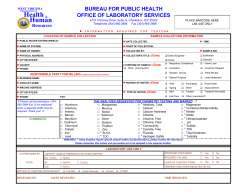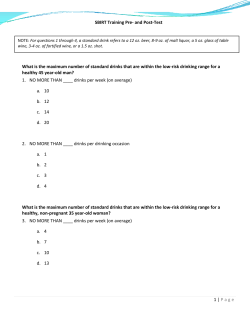
Mark S. Campbell Food Safety and Inspection Service, FERN Division Athens, Georgia
Mark S. Campbell Food Safety and Inspection Service, FERN Division Athens, Georgia USDA/FSIS/FERN Electrochemiluminescence Overview Detection of Clostridium botulinum toxin in drinking water USDA Third largest civilian Dept. of the U.S. Government Over 100,000 employees 15,000 locations in all 50 states and 80 countries Secretary of Agriculture Under Secretary for Food Safety Food Safety and Inspection Service Responsible for insuring that the commercial supply of meat, poultry, and egg products moving in interstate commerce or exported to other countries is safe, wholesome, and correctly labeled and packaged. 250,000 different processed meat and poultry products fall under FSIS inspection. These include hams, sausage, soups, stews, pizzas, frozen dinners, and any product containing 2% or more cooked poultry or at least 3% raw meat. Food Safety and Inspection Service Management Field Operations Policy Program Employee Development Public Health Science Food Security and Emergency Preparedness OPHS has 10 divisions Of these, 4 are field service labs/divisions ◦ Western ◦ Midwestern ◦ Eastern Alameda, CA St. Louis, MO Athens, GA FERN is co-located in Russell Research Center with EL Field Svc labs analyze over 160,000 samples yearly ◦ ◦ ◦ ◦ ◦ Microbiology Chemistry Pathology Extraneous Materials Residues Food Emergency Response Network (FERN) Created in November 2004 HHS-FDA (Beltsville, Md); USDA-FSIS Director’s Office (Athens, Ga) ◦ National Programs Office Branch ◦ Microbiological Food Defense Emergency Branch ◦ Chemical Food Defense Emergency Branch FERN Division Director Office Microbiological Food Security and Emergency Branch Chemical Food Security and Emergency Branch National Program Office Branch Pacific Regional Coordination Center Southeast Regional Coordination Center Central Regional Coordination Center Southwest Regional Coordination Center Northeast Regional Coordination Center Alameda Athens Minneapolis Denver Jamaica, NY Integrate the nation’s multilevel food-testing laboratories to detect, identify, respond to and recover from a bioterrorism or public health emergency/outbreaks involving the food supply 11 HHS-FDA and USDA-FSIS Network provides support and guidance for: ◦ Federal agencies providing joint oversight to coordinate the network’s efforts w/ approximately 165 state lab partners ◦ Food sampling procedures/sample integrity/ sample handling ◦ Analytical detection methods: microbiology, chemistry, rapid assays and radiological methods ◦ Support Program Development & Implementation 12 Detect and identify biological, chemical, and radiological threat agents Prevent threats: operate targeted federal/state surveillance sampling programs Prepare for threats: strengthen lab capacities and capabilities Respond to threats: contribute surge capacity Recovery: assure consumer safety via food testing 13 165 Laboratories representing 50 US States and Puerto Rico have satisfactorily completed FERN Laboratory Qualification Checklists ◦ Affiliations: 35 Federal (FDA, USDA/FSIS, USDA/AMS, DHS, CBP) 115 State 15 Local ◦ Disciplines: 130 Microbiological 104 Chemistry 34 Radiological 14 Plants Food National Plant Diagnostic Network Food Emergency Response Network Animal Environment National Animal Health Laboratory Network Environmental Laboratory Response Human Health Laboratory Response Network M1M Analyzer Touch Screen Computer Small Footprint Load and Go Software flexibility Early Generations •Igen, Origen Analyzer •BioVeris, M1 analyzer M1M version used by: •Military •Civil Support Teams •FERN Sandwich ELISA Detection is based on light Cycling of ion amplifies signal Limited background signal Flow Cell www.bioveris.com Reagents provided to FERN through Critical Reagent Program (CRP) which supports Joint Program Executive Office for Chemical Biological Defense (JPEO-CBD). 20 Tube Holder!! 21 Sample Preparation ◦ Direct sampling (no particulates) ◦ Filter out particulates Assay ◦ Lyophilized antibodies and controls (increase stability) ◦ Short incubation (15 minutes) Time ◦ Approximately 2hour (96 tests) Liquid ◦ No large particulates to clog flow cell ◦ Homogenized Small sample size Appropriate diluents (water, saline) Adapt FERN-developed biotoxin analysis methods to matrices important for EPA’s Standard Analytical Methods compendium ◦ Staphylococcal enterotoxin B (SET B), Clostridium botulinum and Ricin Communis Agglutinin II toxin Drinking water matrix ◦ Produce a method which conforms to the principles used to develop most EPA drinking water methods used for regulatory compliance ◦ Contaminants investigated are not regulated under Safe Drinking Water Act Swabs and soil Factors with potentially affect assay or contribute to analyst degradation Presence of disinfectants ◦ Chlorine/monochloramine Hydrolysis ◦ Water is present in an overwhelming amount compared to analyte Microbial degradation (resistant) Metals, organic matter Free chlorine (3.0 mg/L) ◦ Diluted household bleach in potassium dihydrogen phosphate buffer (pH 8.0) monochloramine (2.0 mg/L) ◦ 2.2:1 molar ration of ammonium chloride:bleach is added to 50 mM potassium dihydrogen phosphate buffer (pH 8.0) Additives to address drinking water challenges ◦ Ammonium chloride, sodium thiosulfate, sodium sulfite, ascorbic acid, ammonium acetate, citric acid, diazolidinyl urea, ammonium sulfate, etc Fluorescence value (thousands) Standard dilution curve 16 Distilled water R2 = 0.9992 14 12 Monochloramine R² = 0.9993 10 8 6 4 2 Chlorine 0 0 5 10 15 20 C. bot B toxin (ng/ml) 25 30 35 Matrix Results (Time zero); 20ng/ml Free chlorine + ammonium chloride (0.1g/L) Detected Free chlorine + sodium thiosulfate (0.08g/L) Detected Free chlorine + sodium sulfite (0.05g/L) Detected Free chlorine + ascorbic acid (0.1g/L) Detected Free chlorine + ammonium acetate (1.5g/L) Detected Free chlorine + ammonium sulfate (1.5g/L) ____ Monochloramine + sodium thiosulfate (0.08g/L) DI water + citric acid (9.3g/L) Detected Not detected DI water + diazolidinyl urea (1.0g/L) Detected Local Tap water (0 to 0.45ppm) Detected For botulinum toxin • Dechlorinated/preserved samples are held at 10oC for 48 hrs, followed by an extended holding time at 4oC (7, 14, and 28 days) • 3-4 real drinking water samples • Validate assay (2-3 FERN laboratories) • Additional analysis platforms For project • Other environmental matrices (soils, surfaces) • Other biotoxins (ricin, SEB, etc.) Disclaimer: The U.S. Environmental Protection Agency (EPA) funded through Interagency Agreement #DW-12-92304701 managed and/or collaborated in the research described in this presentation. It has been subject to an administrative review but does not necessarily reflect the views of EPA. No official endorsement should be inferred. EPA does not endorse the purchase or sale of any commercial or noncommercial products or services.
© Copyright 2025





















